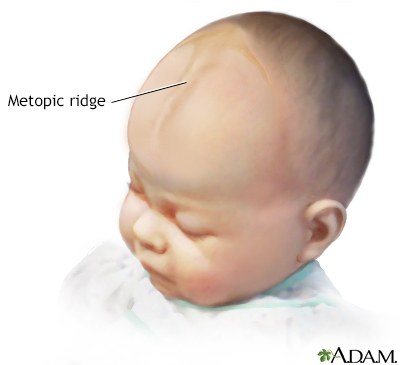Metopic ridge
Definition
A metopic ridge is an abnormal shape of the skull. The ridge can be seen on the forehead.
Considerations
The skull of an infant is made up of bony plates. The gaps between the plates allow for growth of the skull. The places where these plates connect are called sutures or suture lines. They do not fully close until the 2nd or 3rd year of life.
A metopic ridge occurs when the 2 bony plates in the front part of the skull join together too early.
The metopic suture remains unclosed throughout life in 1 in 10 people.
Causes
A birth defect called craniosynostosis is a common cause of metopic ridge. It can also be associated with other congenital skeletal defects.
When to Contact a Medical Professional
Contact your health care provider if you notice a ridge along your infant's forehead or a ridge forming on the skull.
The provider will perform a physical exam and ask questions about the child's medical history.
Tests may include:
- Head CT scan
- Skull x-ray
A metopic ridge must be differentiated from metopic synostosis, which is a more serious condition. Parents can find information and support at www.cappskids.org/metopic-ridge/.
No treatment or surgery is needed for a metopic ridge if it is the only skull abnormality.
Gallery


References
Craniosynostosis and Positional Plagiocephaly Support (CAPPS) website. The metopic ridge / benign or surgical? www.cappskids.org/metopic-ridge/. Accessed January 28, 2022.
Gerety PA, Taylor JA, Bartlett SP. Nonsyndromic craniosynostosis. In: Rodriguez ED, Losee JE, Neligan PC, eds. Plastic Surgery: Volume 3: Craniofacial, Head and Neck Surgery and Pediatric Plastic Surgery. 4th ed. Philadelphia, PA: Elsevier; 2018:chap 32.
Jha RT, Magge SN, Keating RF. Diagnosis and surgical options for craniosynostosis. In: Ellenbogen RG, Sekhar LN, Kitchen ND, da Silva HB, eds. Principles of Neurological Surgery. 4th ed. Philadelphia, PA: Elsevier; 2018:chap 9.
Kinsman SL, Johnston MV. Congenital anomalies of the central nervous system. In: Kliegman RM, St. Geme JW, Blum NJ, Shah SS, Tasker RC, Wilson KM, eds. Nelson Textbook of Pediatrics. 21st ed. Philadelphia, PA: Elsevier; 2020:chap 609.